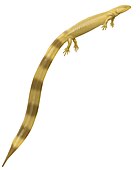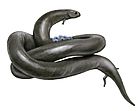
Dissorophidae is an extinct family of medium-sized, temnospondyl amphibians that flourished during the late Carboniferous and early Permian periods. The clade is known almost exclusively from North America.

Microsauria is an extinct, possibly polyphyletic order of amphibians from the late Carboniferous and early Permian periods. It is the most diverse and species-rich group of lepospondyls. Recently, Microsauria has been considered paraphyletic, as several other non-microsaur lepospondyl groups such as Lysorophia seem to be nested in it. Microsauria is now commonly used as a collective term for the grade of lepospondyls that were originally classified as members of Microsauria.

Acroplous is an extinct genus of dvinosaurian Temnospondyli within the family Eobrachyopidae.

Batropetes is an extinct genus of brachystelechid recumbirostran "microsaur". Batropetes lived during the Sakmarian stage of the Early Permian. Fossils attributable to the type species B. fritschi have been collected from the town of Freital in Saxony, Germany, near the city of Dresden. Additional material has been found from the Saar-Nahe Basin in southwestern Germany and has been assigned to three additional species: B. niederkirchensis, B. palatinus, and B. appelensis.
Carrolla is an extinct genus of brachystelechid 'microsaur' that lived in the Lower Permian in North America. It was named in 1986 by American paleontologists Wann Langston and Everett Olson. The type species, Carrolla craddocki, is the only known species.

Euryodus is an extinct genus of microsaur within the family Gymnarthridae. Euryodus is a Lepospondyl from the clade Microsauria that lived during the Lower Permian. The name comes from Greek, meaning ‘broad-tooth’. It has been found in the southern half of North America, from its original discovery in Texas up to Utah.
Llistrofus is an extinct genus of early Permian microsaur within the family Hapsidopareiidae that is known from Oklahoma.
Ostodolepis is an extinct genus of microsaur within the family Ostodolepidae. It is known from the Arroyo Formation in Texas.
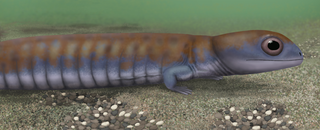
Odonterpeton is an extinct genus of microsaur It is known from a single specimen found in Late Carboniferous coal measures in Ohio. It is now considered to be a member of the "microsaur" clade Recumbirostra, and the sister species of Joermungandr from Mazon Creek.
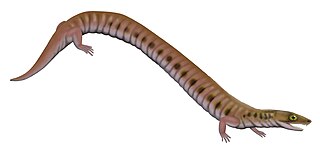
Rhynchonkos is an extinct genus of microsaur. It is the only known member of the family Rhynchonkidae. Originally known as Goniorhynchus, it was renamed in 1981 because the name had already been given to another genus; the family, likewise, was originally named Goniorhynchidae but renamed in 1988. The type and only known species is R. stovalli, found from the Early Permian Fairmont Shale in Cleveland County, Oklahoma. Rhynchonkos shares many similarities with Eocaecilia, an early caecilian from the Early Jurassic of Arizona. Similarities between Rhynchonkos and Eocaecilia have been taken as evidence that caecilians are descendants of microsaurs. However, such a relationship is no longer widely accepted.
Quasicaecilia is an extinct genus of microsaur. It is known from the Early Permian of Texas in the United States. A single specimen is known, collected from the Texas Permian redbeds by Charles Hazelius Sternberg in 1917. It was originally identified as a specimen of the gymnarthrid microsaur Cardiocephalus. The skull is small, less than 2 centimetres (0.79 in) in length, and the otic capsule is very large in comparison to the rest of the skull. The skull of Quasicaecilia superficially resembles those of extant but unrelated caecilians, hence the genus name. Quasicaecilia was assigned to the new family Brachystelechidae in 1991 along with the genera Batropetes and Carrolla.
Stegotretus is an extinct genus of lepospondyl microsaur referred to the Pantylidae. It is known from the Carboniferous–Permian boundary Cutler Formation exposures of New Mexico.
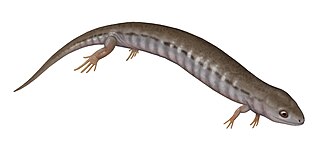
Hyloplesion is an extinct genus of microbrachomorph microsaur. It is the type and only genus within the family Hyloplesiontidae. Fossils have been found from the Czech Republic near the towns of Plzeň, Nýřany, and Třemošná, and date back to the Middle Pennsylvanian. The type species is H. longicostatum, named in 1883. Two species belonging to different genera, Seeleya pusilla and Orthocosta microscopica, have been synonymized with H. longicostatum and are thought to represent very immature individuals.

Tuditanomorpha is a suborder of microsaur lepospondyls. Tuditanomorphs lived from the Late Carboniferous to the Early Permian and are known from North America and Europe. Tuditanomorphs have a similar pattern of bones in the skull roof. Tuditanomorphs display considerable variability, especially in body size, proportions, dentition, and presacral vertebral count. Currently there are seven families of tuditanomorphs, with two being monotypic. Tuditanids, gymnarthrids, and pantylids first appear in the Lower Pennsylvanian. Goniorhynchidae, Hapsidopareiontidae, Ostodolepidae, and Trihecatontidae appear in the Late Pennsylvanian and Early Permian.
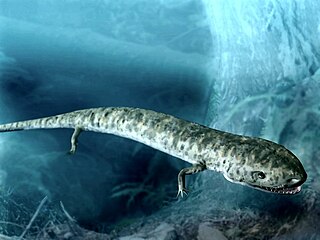
Gymnarthridae is an extinct family of tuditanomorph microsaurs. Gymnarthrids are known from Europe and North America and existed from the Late Carboniferous through the Early Permian. Remains have been found from the Czech Republic, Nova Scotia, Illinois, Texas, and Oklahoma.
Parioxys is an extinct genus of temnospondyl amphibian from the Early Permian of Texas.
Huskerpeton is an extinct genus of recumbirostran from the Early Permian period. They belong to the order Microsauria, which was estabished in 1863 by Dawson, and was quickly expanded to include many different small taxa. They lived in what is now Nebraska and Kansas. The holotype of Huskerpeton was uncovered at the Eskridge formation in Nebraska, which is part of how it got its name.
Proxilodon is an extinct genus of recumbirostran microsaur from the Early Permian Speiser Formation of Kansas, United States. It contains a single species, Proxilodon bonneri,.
The Arroyo Formation is a geologic formation in Texas. It preserves fossils dating back to the Kungurian stage of the Permian period. It is the lower-most portion of the Clear Fork Group, part of a series of fossiliferous Permian strata in the south-central United States known as the red beds.

Richards Spur is a Permian fossil locality located at the Dolese Brothers Limestone Quarry north of Lawton, Oklahoma. The locality preserves clay and mudstone fissure fills of a karst system eroded out of Ordovician limestone and dolomite, with the infilling dating to the Artinskian stage of the early Permian (Cisuralian), around 289 to 286 million years ago. Fossils of terrestrial animals are abundant and well-preserved, representing one of the most diverse Paleozoic tetrapod communities known. A common historical name for the site is Fort Sill, in reference to the nearby military base. Fossils were first reported at the quarry by workers in 1932, spurring a wave of collecting by local and international geologists. Early taxa of interest included the abundant reptile Captorhinus and microsaurs such as Cardiocephalus and Euryodus. Later notable discoveries include Doleserpeton, the most diverse assortment of parareptiles in the Early Permian, and the rare early diapsid Orovenator.











